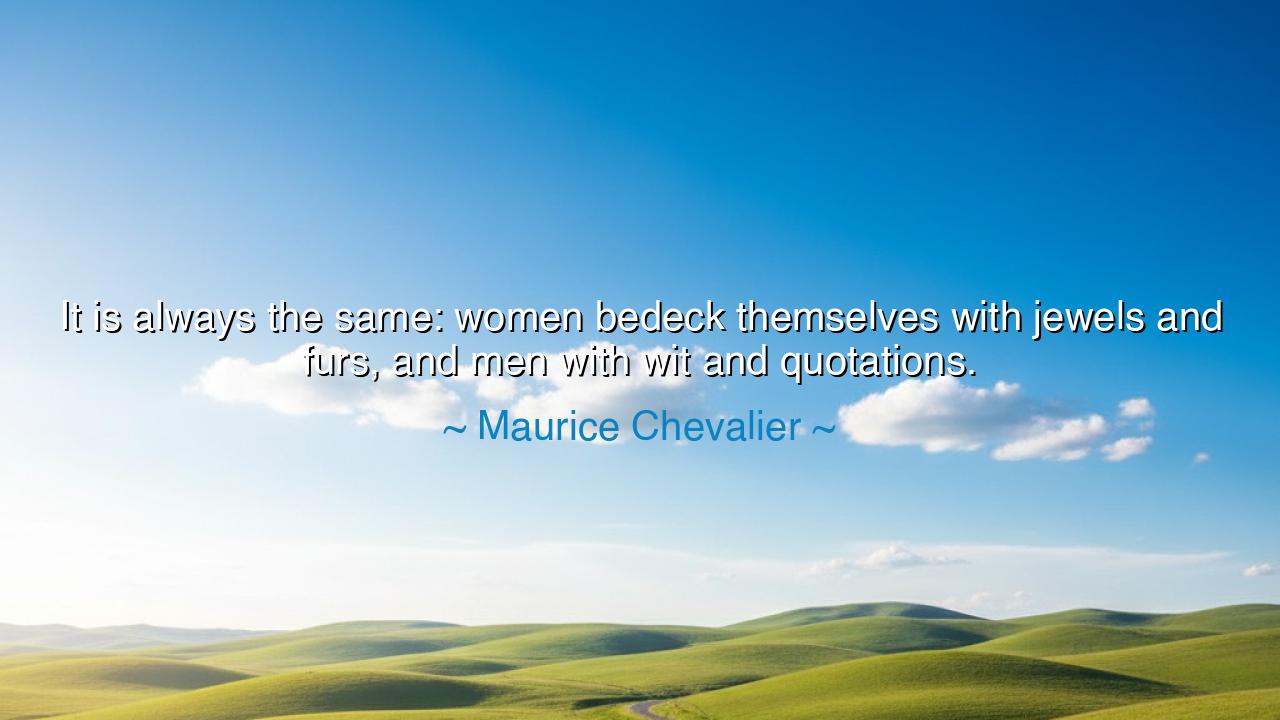
It is always the same: women bedeck themselves with jewels and
It is always the same: women bedeck themselves with jewels and furs, and men with wit and quotations.






Hear the wry wisdom of Maurice Chevalier, who observed the ways of men and women and declared: “It is always the same: women bedeck themselves with jewels and furs, and men with wit and quotations.” In these words lies not only humor but a reflection upon the age-old art of presentation—the manner in which humanity seeks to adorn itself before the eyes of others.
For women, he says, turn to jewels and furs, clothing themselves in the radiance of gold and the luxury of rare skins. These adornments are symbols of beauty, wealth, and allure, shining outward as a call to admiration. Such has been the custom of courts and kingdoms through the ages, where women were praised for elegance and splendor, their outward form raised as the mirror of grace.
But men, Chevalier reminds us, cloak themselves not in jewels but in wit and quotations. Their adornment is of the mind, the quick tongue, the clever phrase borrowed from sages of old. Just as women polish gems to catch the light, men polish words to catch attention, hoping that intellect—or at least the echo of intellect—will secure them admiration and esteem.
The origin of this saying lies in the long dance between the sexes, each shaped by society to display in different ways what they hope to be valued for. Women, through history, were too often measured by beauty and ornament; men, by intellect and eloquence. Chevalier, with playful irony, exposes the performance in both, showing that each sex has its costume, each its mask.
Yet within the jest is a lesson: adornment, whether of jewels or words, is but surface. True worth lies not in what is displayed but in what is real. The jewel fades when the heart is empty, and the quotation is hollow when the soul has no wisdom of its own. Let the generations remember—adornment may charm the eye or ear, but character alone endures.






LTLam Tran
I find this quote interesting because it speaks to how society has historically defined men and women based on superficial attributes. Women are often expected to flaunt beauty and wealth, while men are expected to show off their intelligence. In today’s world, though, I wonder if these outdated ideas are still relevant. Could we shift the conversation to focus on what truly matters—individuality and substance—rather than these surface-level symbols?
NDTu Nguyen Dinh
Maurice Chevalier’s comment is amusing, but it also raises questions about identity. If women are expected to adorn themselves with material things and men with intellect, does this reinforce traditional stereotypes about what men and women should value or strive for? How do we challenge these expectations and promote a more inclusive view of self-worth, where both intellect and appearance are valued equally for anyone?
NNNgan Nguyen
This quote offers a witty critique of societal norms. It seems like Chevalier is highlighting how men and women use different 'tools' to assert their place in the world—women with their appearance and men with their words. But does this imply that one form of self-expression is more valid than the other? Are we limiting ourselves by still holding onto these expectations for how people should present themselves?
LLinh
Chevalier’s quote seems to reflect the way we’ve historically separated genders based on attributes: women with material wealth and men with intellect. Is this still the case today? Or have we evolved in how we perceive gender roles and value? Can both women and men express their individuality in ways that aren’t tied to traditional symbols, such as jewels or wit, and still be respected?
DDDung Doan
I think there’s a deeper message here about how people—especially in traditional roles—are often valued for external traits. Women with jewels and furs and men with wit and quotations seem to reflect superficial distinctions. But are we still living in a world where external displays of wealth or intellect are the most valued traits? Have we moved beyond these old ideas, or do they still influence us?